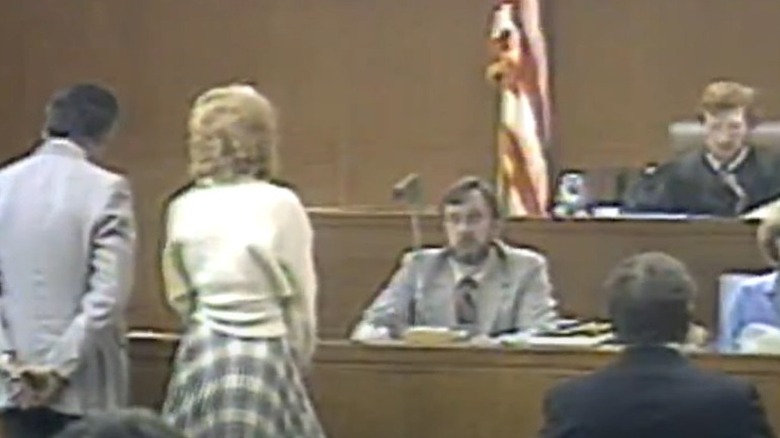The Weird Story Of A Playboy Bunny Who Became A Cop And Then Committed Murder
Compared to Laurie Bembenek, most of us have adult lives as dull as dishwater. Bembenek was trying her hand at a modeling career in the late 1970s when she was featured in a calendar by Schlitz beer. Not able to get the start she needed to get noticed in this field, she worked briefly as a cocktail waitress at the Lake Geneve Playboy Club, donning the ears and tails that cemented her in history as one of the storied Playboy Bunnies (via Milwaukee Magazine).
But with her modeling career fizzling out almost as soon as it started, Bembenek began exploring other career options. In 1980, she began gravitating toward a career in law enforcement. Joining a club to get into peak shape, Bembenek worked on her stamina and physique before applying to become a trainee for the Milwaukee Police Department. At the age of 21, she was accepted into their training academy after passing a series of tests. In the summer of 1980, Bembenek graduated from the academy after 21 weeks of rigorous training and was assigned to a unit. But after allegations of marijuana possession, she was fired not even a month into the job.
Only able to find work as a babysitter at that point, Bembenek met police detective Elfred Schultz through one of her charges. They married in January 1981, months after their initial meeting. Working now as a part-time physical trainer, Bembenek began to harbor some animosity toward her new husband's ex-wife. This would prove to be her undoing in the following months.
Bembenek is found guilty of murder
Milwaukee Magazine reports that Laurie Bembenek and her new husband found that money was getting tight after their roommate moved out of the home they shared several months after they became man and wife. The news outlet writes that Elfred Schultz was paying his ex-wife's rent, in addition to paying a monthly amount for child support. All told, the money from Schultz to his ex Christine totaled over $700, a sum that Bembenek was said to be unhappy with.
Just after midnight on May 28, 1981, it was reported that someone entered Christine Schultz's apartment. The woman was tied up and then shot once in the back and left for dead. One of Christine's children reportedly saw the intruder, who they described as a man. She was killed with a gun later identified as the service revolver belonging to Elfred Schultz.
Prosecutors constructed a case against Bembenek, however. Receiving information from witnesses that would later testify that Bembenek talked of killing Christine, the state pieced together enough circumstantial evidence to charge her with murder. Though Christine's son stated it wasn't Bembenek who murdered his mother, the state argued that she had a motive, access to a key to Christine's apartment, and wore a disguise (per truTV).
Bembenek was convicted of first-degree murder and sentenced to life in prison. But this wasn't the end of her story by a long shot. Even after losing three post-conviction appeals, Bembenek wasn't done with the world.
Escape from prison and life on the run
Milwaukee Magazine details Laurie Bembenek's life after her 1982 conviction. With a life sentence ahead of her, she began to make the most of her time behind bars at the Taycheedah Women's Prison. She earned her bachelor's degree while incarcerated and also helped to start up a newspaper for the inmates.
But after more than eight years locked up, she decided to escape. Aided by the brother of one of her new prison friends, Bembenek made a daring escape through the laundry room window of the facility and managed to climb over a barbwire-topped fence. She and her accomplice, Dominic Gugliatto, immediately moved to Thunder Bay, Ontario, where Bembenek thought she might get some lenience from the Canadian government. Meanwhile, in Wisconsin, supporters of Bembenek's, numbering in the hundreds, began to gather outside of the prison upon the news of her escape. Donning "Run, Bambi, Run" t-shirts, they drew attention to the case the Bembenek had been making for the last decade that outlined her innocence (per the Los Angeles Daily News).
The couple managed to scrape by, but her newfound freedom ended after three short months. Caught soon after by Canadian authorities, extradition proceedings against her soon begun. She managed to delay this for nearly two years before she lost and was sent back to Taycheedah, where she was immediately put in restrictive custody.
Bembenek's case wasn't quite over yet, however.
A lucky break in her second trial set her free
A statement from the judge's bench that outlined all of the mistakes made in Laurie Bembenek's first trial breathed new life into her case. The Los Angeles Daily News reports that the statement prompted Bembenek to enter into a rare deal with prosecutors that would lead to her freedom. The deal included Bembenek pleading guilty to one charge of second-degree murder and receiving credit for time served. As the sentence was 10 years, this allowed her to be free. Prosecutors also negotiated for her to stay on probation for an additional 10 years.
Maintaining her innocence in the media in the aftermath of the agreement that led to her freedom, Bembenek struggled to live a normal life for years after her release. She violated her probation with a drug charge at one point but was not reincarcerated. She applied to have her parole moved to the state of Washington, which was approved in 1997. Though she had trouble maintaining employment at first, Milwaukee Magazine reports that she was eventually employed by a not-for-profit that helped troubled youth. She also took up painting and was able to get a fan base for her work. Of course, her notoriety from her memoirs and her highly publicized trial, escape, and eventual release might have helped her garner some patrons.
A fall from a window led to her leg being amputated
Fox News reports what might be the most unusual story about Laurie Bembenek in her post-release years. After the gallery that housed her paintings burned down, consuming all 30 of her original works of art, she agreed to make an appearance on the "Dr. Phil Show." Dr. Phil had agreed to pay the $20,000 sum for the DNA test that was now available to test evidence never before tested from the crime scene that landed Bembenek in prison.
But while in the hotel room, Bembenek leaped from her second-floor hotel room window. One of her legs was so damaged in the fall that she had to have half of it amputated. Later claiming that she was driven to jump by the post-traumatic stress disorder she suffered from her time in solitary confinement, Bembenek blamed a severe panic attack for her action (per Milwaukee Magazine).
If you or someone you know is struggling with mental health, please contact the Crisis Text Line by texting HOME to 741741, call the National Alliance on Mental Illness helpline at 1-800-950-NAMI (6264), or visit the National Institute of Mental Health website.
Bembenek died young
After a life full of many ups and downs, framed by dramatic twists and turns, Laurie Bembenek met an early end. Her death was announced on Saturday, November 20, 2010. She had been suffering from liver cancer. She was 52.
According to the Milwaukee Journal Sentinel, Bembenek succumbed to both liver and kidney failure. Her sister, Colette Bembenek, made the announcement, stating that she passed away while in hospice care in Portland, Oregon. She worked throughout the remainder of her life to clear her name of the murder that she says she didn't commit, making endless pleas to the Wisconsin authorities to pardon her. After her death, Governor Jim Doyle stated through a spokesperson that Bembenek's most recent application for a pardon had not been completed, and the state's top executive had no plans of reviewing it any time shortly.
A decade later, Bembenek's attorney Mary Woehrer is still actively working to get her client's dying wish for a pardon granted (via TMJ4 News). As of today, this wish has gone unfulfilled.





